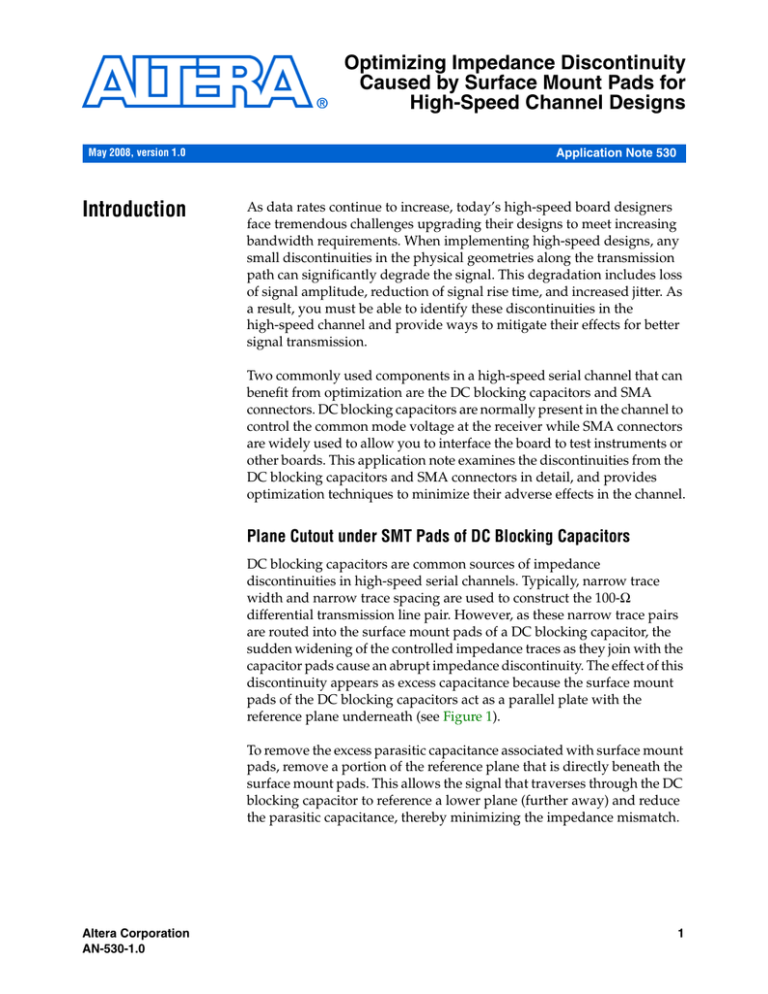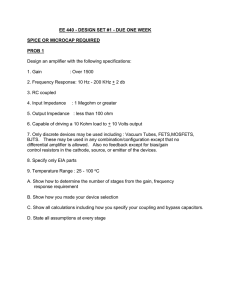
Optimizing Impedance Discontinuity
Caused by Surface Mount Pads for
High-Speed Channel Designs
May 2008, version 1.0
Introduction
Application Note 530
As data rates continue to increase, today’s high-speed board designers
face tremendous challenges upgrading their designs to meet increasing
bandwidth requirements. When implementing high-speed designs, any
small discontinuities in the physical geometries along the transmission
path can significantly degrade the signal. This degradation includes loss
of signal amplitude, reduction of signal rise time, and increased jitter. As
a result, you must be able to identify these discontinuities in the
high-speed channel and provide ways to mitigate their effects for better
signal transmission.
Two commonly used components in a high-speed serial channel that can
benefit from optimization are the DC blocking capacitors and SMA
connectors. DC blocking capacitors are normally present in the channel to
control the common mode voltage at the receiver while SMA connectors
are widely used to allow you to interface the board to test instruments or
other boards. This application note examines the discontinuities from the
DC blocking capacitors and SMA connectors in detail, and provides
optimization techniques to minimize their adverse effects in the channel.
Plane Cutout under SMT Pads of DC Blocking Capacitors
DC blocking capacitors are common sources of impedance
discontinuities in high-speed serial channels. Typically, narrow trace
width and narrow trace spacing are used to construct the 100-Ω
differential transmission line pair. However, as these narrow trace pairs
are routed into the surface mount pads of a DC blocking capacitor, the
sudden widening of the controlled impedance traces as they join with the
capacitor pads cause an abrupt impedance discontinuity. The effect of this
discontinuity appears as excess capacitance because the surface mount
pads of the DC blocking capacitors act as a parallel plate with the
reference plane underneath (see Figure 1).
To remove the excess parasitic capacitance associated with surface mount
pads, remove a portion of the reference plane that is directly beneath the
surface mount pads. This allows the signal that traverses through the DC
blocking capacitor to reference a lower plane (further away) and reduce
the parasitic capacitance, thereby minimizing the impedance mismatch.
Altera Corporation
AN-530-1.0
1
Application Note 530: Optimizing Impedance Discontinuity Caused by Surface Mount Pads for
High-Speed Channel Designs
Figure 1. Ansoft HFSS Setup of DC Blocking Capacitors with and without Plane Cutout under SMT Pads
Simulations for the normal routing structure and optimized routing
structure of DC blocking capacitors were compared using Ansoft’s HFSS
3D Field Simulator tool. The HFSS setup is shown in Figure 1.
In Figure 1, the picture on the left is the normal structure without the
plane cutout underneath; the picture on the right is the optimized
structure with the plane cutouts included. For these simulations, the
board stackup and trace geometries are designed to provide a 100 Ω
differential signal. All traces and plane layers are set as 1 oz. copper. The
width of the surface mount pads is initially set to 20 mils to match the
width of the 0402 type capacitors that is modeled. Here, the critical
parameter for optimization involves the width of the cutout underneath
the surface mount pads. The length of the cutout is always equal to the
end-to-end distance of two surface mount pads, which is set to 60 mils in
this simulation. The ground vias near the DC blocking capacitors are
recommended to provide the current return path. Additionally,
simulation waveports are defined at the two ends of the differential
traces. A simulation sweep performed by varying the width of the cutout
from the initial 20 mils to 35 mils, in 5 mils increments, yields the
optimum plane cutout size for this particular simulation.
Figure 2 shows the TDR impedance plot from the Ansoft HFSS
simulation. The red line is the impedance profile of the high-speed
differential traces without the plane cutout under the surface mount pads
of the DC blocking capacitors. The blue, black, green, and purple lines are
the impedance profiles with the width of cutout set to 20 mils, 25 mils,
30 mils, and 35 mils, respectively.
Altera Corporation
2
Application Note 530: Optimizing Impedance Discontinuity Caused by Surface Mount Pads for
High-Speed Channel Designs
The simulation results show that the width of the plane cutout plays an
important role in minimizing the impedance mismatch. The impedance
without the plane cutout is approximately 75 Ω at the DC blocking
capacitor pads. The minimum impedance mismatch is achieved when the
width of the cutout is 25 mils. The optimum routing structure, which has
a 25-mil wide cutout under the capacitor, gives approximately 95 Ω
differential impedance, which falls within the typical ±10% tolerance
requirements for the 100 Ω differential pair.
Figure 2. Impedance Profile with Different Width of Plane Cutout underneath the SMT Pads
Impedance Profile vs. Width of Plane Cut-out
105
Impedance (Ohm)
100
95
no cut-out
90
20 mil wide
25 mil wide
85
30 mil wide
80
35 mil wide
75
70
0
100
200
300
400
500
600
Tim e (ps)
Figure 3 shows the plot of the differential return loss computed by HFSS.
The return loss is a measure of the reflected energy from the
discontinuities in an electrical link. It is the ratio of the reflected energy
(PR) to the incident energy (PT) and expressed as 20log10 (PR/PT) in
negative decibels. For example, -20dB return loss means that 10% of the
energy is reflected while 90% of the energy is transmitted through.
The red line in Figure 3 represents the differential return loss of the
high-speed traces without the plane cutout underneath the surface mount
pads. The blue, black, green, and purple lines in Figure 3 represent the
differential return losses of the channel when the width of the plane
cutout is set to 20 mils, 25 mils, 30 mils, and 35 mils, respectively.
Altera Corporation
3
Application Note 530: Optimizing Impedance Discontinuity Caused by Surface Mount Pads for
High-Speed Channel Designs
In Figure 3, the return loss without the plane cutout crosses the -20dB
point at 1.4 GHz, while the optimum structure with 25 mils wide cutout
does not reach the -20dB line until above 20 GHz. The frequency response
of the optimized routing structure is significantly improved over the
normal routing structure.
Figure 3. Differential Return Loss with Different Width of Plane Cutout under the SMT Pads
Plane Cutout under SMT Pads of SMA Connectors
SMA connectors are widely used in high-speed PCBs to interface the
board with a test instrument or with other boards. These connectors are
typically surface mount type for the center conductor with four
surrounding pins mounted as through-holes for grounding and
connection strength (see Figure 4). This structure allows the stable
attachment of the SMA cables while maintaining good signal integrity.
Using these connectors in the high-speed transmission path presents a
similar problem to the characteristic impedance that was observed with
the DC blocking capacitors. That is, the typically narrow trace that is used
to construct the 50 Ω transmission line is routed into the surface mount
pad of the SMA. The sudden widening of this trace as it meets the larger
center conductor pad of the SMA causes the characteristic impedance to
Altera Corporation
4
Application Note 530: Optimizing Impedance Discontinuity Caused by Surface Mount Pads for
High-Speed Channel Designs
be reduced. As a result, you can use the same technique of removing the
ground plane underneath the surface mount pads to minimize the
sudden impedance mismatch caused by the smaller signal trace abruptly
meeting the larger surface mount pads of the SMA.
Figure 4. Ansoft HFSS Setup of SMA Connector with and without Plane Cutout Underneath
Simulations for the normal routing structure of an SMA (without plane
cutout beneath the SMT pad) versus the optimized routing structure
(with plane cutout underneath) were performed using HFSS. The
simulation set up is shown in Figure 4.
In Figure 4, the picture on the left is the setup for the normal
implementation where the center pin of the SMA is directly connected to
the surface mount pad and there is no cutout below the center
conductor’s pad. In the picture on the right, the optimized routing
structure has the same set up as the normal routing structure with the
exception of a large circular ring cut out on the reference plane beneath.
Providing this plane cutout allows the surface mount pad to reference to
a lower plane and reduce the parasitic capacitance caused by the surface
mount pad of the SMA. Reducing this parasitic capacitance improves the
impedance matching between the signal trace and the center conductor
pad of the SMA.
In the simulation, all traces and plane layers are set as 1 oz. copper.
Waveport 1 is defined at the beginning of the 50-Ω trace that routes into
the surface mount pad, while waveport 2 is defined at the end of the SMA
connector. The critical parameter for optimization is the radius of the
circular ring of the cutout. For this simulation, the radius of the circular
ring cutout is swept from an initial value of 15 mils to 20 mils, and then to
25 mils.
Altera Corporation
5
Application Note 530: Optimizing Impedance Discontinuity Caused by Surface Mount Pads for
High-Speed Channel Designs
Figure 5 shows the TDR impedance plot result comparison from HFSS.
The red line is the impedance profile of the 50-Ω transmission line without
the plane cutout. The blue, black, and green lines are the impedance
profiles of the trace with the radius of the circular cutout set to 15 mils,
20 mils, and 25 mils, respectively.
The simulation results show that the radius of the cutout plays an
important role in optimizing the impedance mismatch. The impedance
mismatch without the plane cut out is greater than 25 Ω from the desired
nominal impedance of 50 Ω . The minimum impedance mismatch is
achieved when the radius of the circular cutout is set to 25 mils for this
particular simulation. This improvement yields less than 5 Ω of
impedance mismatch, which is within the typical ±10% tolerance
requirements of a 50-Ω transmission line.
Figure 5. Impedance Profile with Different Radius of Circular Cutout under the SMT Pads of SMA
Impedance Profile vs. Radius of Circular Cutout
Impedance (Ohm)
55
no cutout
45
radius = 15mil
35
radius = 20mil
25
15
radius = 25mil
0
200
400
600
Time (ps)
Figure 6 shows the plot of the return loss computed by HFSS. The red line
is the return loss of the 50-Ω trace without the plane cutout underneath
the surface mount pads. The blue, black, and green lines are the return
losses of the channel when the radius of the circular cutout is set to
15 mils, 20 mils, and 25 mils, respectively.
The return loss for the normal implementation crosses the -20dB line at
approximately 1.4 GHz, while the return loss of the optimum routing
structure with 25 mil radius of the circular cutout does not reach the
-20dB line until approximately 8 GHz. As shown in Figure 6, the
frequency response of the optimized routing structure is significantly
improved over the normal routing structure for frequencies up to 8 GHz.
Altera Corporation
6
Application Note 530: Optimizing Impedance Discontinuity Caused by Surface Mount Pads for
High-Speed Channel Designs
Figure 6. Return Loss with Different Radius of Circular Cutout under the SMT Pads of SMA
Summary
The surface mount pads used in DC blocking capacitors and SMA
connectors are two common sources of impedance discontinuities in
high-speed serial channels. Impedance discontinuity can significantly
degrade the performance of the signal. You must carefully analyze and
design these structures to ensure optimal performance, especially at
multi-gigabit data rates. The techniques described in this application note
show you how to optimize impedance discontinuities for high-speed
channel designs.
References
■
■
Altera Corporation
Altera® TB 095 High-Speed Board Design Advisor: High-Speed Channel
Design and Layout.
Altera net seminar Gigabit Channel Design Guidelines by Leonard
Dieguez and Salman Jiva.
7
Application Note 530: Effects of Plane Cutouts Under Surface Mount Pads for High-Speed Channel
Designs
101 Innovation Drive
San Jose, CA 95134
www.altera.com
Technical Support
www.altera.com/support
Literature Services:
literature@altera.com
8
Copyright © 2008 Altera Corporation. All rights reserved. Altera, The Programmable Solutions Company,
the stylized Altera logo, specific device designations, and all other words and logos that are identified as
trademarks and/or service marks are, unless noted otherwise, the trademarks and service marks of Altera
Corporation in the U.S. and other countries. All other product or service names are the property of their respective holders. Altera products are protected under numerous U.S. and foreign patents and pending
applications, maskwork rights, and copyrights. Altera warrants performance of its semiconductor products
to current specifications in accordance with Altera's standard warranty, but reserves the right to make changes to any products and services at any time without notice. Altera assumes no responsibility or liability
arising out of the application or use of any information, product, or service described
herein except as expressly agreed to in writing by Altera Corporation. Altera customers
are advised to obtain the latest version of device specifications before relying on any published information and before placing orders for products or services.
Altera Corporation


